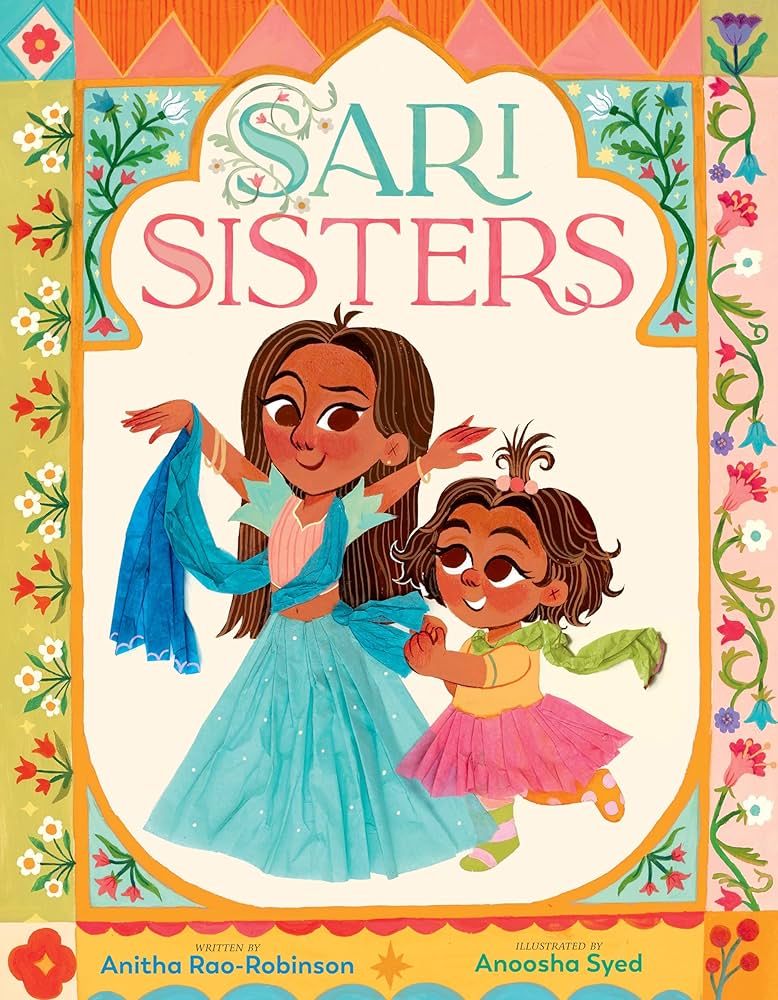Sari Sisters

Sari Sisters
Ruhi spins in her room, waiting for her sister. She and Kayra always start the weekend dancing. Just the two of them. Everything’s ready—the music, the lights, the glitter balls. But where’s Kayra?
Ruhi is ready for her weekend dance party with her sister Kayra. As the above excerpt indicates, Ruhi has everything ready, but her sister is not coming out of her room. Ruhi calls out to her and knocks on her door; Kayra yells that she is too old for that activity now. Ruhi is bored and disappointed, and her Amma (a South Asian term for mom) says that Kayra might play with her later, but today is a big day for Kayra. Saris are one of the most common outfits worn by women on the Indian subcontinent, including India, Sri Lanka, Pakistan, Bangladesh and Nepal. A sari is also a symbol of a girl’s coming-of-age and traditionally young girls wear lenghas or half-saris until they are old enough for a sari.
As Ruhi wonders why she is not included in this ‘big day’, Kayra comes out of her room, and Ruhi is shocked. Kayra looks so beautiful; she is wearing a sari, Ruhi tries to touch it, but Kayra thinks she will ruin her sari. Ruhi loves saris and reminisces about all the beautiful saris that her Amma wears and which ones she wants to wear one day.
When Ruhi begs her mom to wear a sari; her mom responds by promising that she can when she is older and able to handle all the fabric without tripping. Ruhi and Kayra get in the car to visit with their family. As soon as they pull up in the driveway, the aunties fiddle and fuss with Kayra’s sari.
Ruhi’s cousins pull her down to the playroom; however, Ruhi sees Kayra sitting with the aunties, smoothing out her sari and looking very grown-up. Ruhi feels left out and, even though her cousins are playing and laughing, she sits alone. She wishes she got to help her sister put the sari on, feel the fabric and dance in it. As she sees her cousins dancing to the music, jumping and grooving, Ruhi has a great idea.
Once she is home, Ruhi searches around the house and gathers as many scarves as she can and practices tying them like a sari, but doing so is harder than it looks. When she sees her cousins the next weekend, she shows them all the scarves and fabric she has brought, and they all wrap them around in different styles. Saris are worn in different ways and styles throughout India depending on the region and occasion. With modern styles and traditional sari wrapping, there are over eighty ways to wear one. In Sanskrit, sari means ‘a strip of cloth’, but it is actually five or six yards of long cloth that make up a sari. Author Anitha Rao-Robinson believes that the process of wearing a sari is a form of art.
Ruhi and her cousins call all the adults down and dance, jump and shimmy in their saris. Ruhi finds Kayra and pulls her into the crowd. As they are dancing, Ruhi trips as her sari unravels, exactly as her Amma said might happen. Luckily, Kayra is there to help her tie it back and keep on dancing. They both agree that next week they will tie and wrap their saris together.
Anoosha Syed creates her illustrations using a combination of gouache, colour pencils and tissue paper collage. The images are delightful, and there is movement in the clothing. The collage really making the saris and details stand out.
Nisha Prajapati is a librarian in Toronto, Ontario.
